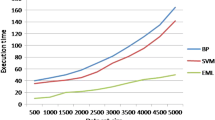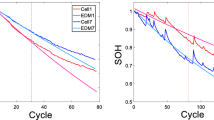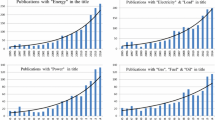Abstract
A support vector machine (SVM) forecasting model based on rough set (RS) data preprocess was proposed by combining the rough set attribute reduction and the support vector machine regression algorithm, because there are strong complementarities between two models. Firstly, the rough set was used to reduce the condition attributes, then to eliminate the attributes that were redundant for the forecast, Secondly, it adopted the minimum condition attributes obtained by reduction and the corresponding original data to re-form a new training sample, which only kept the important attributes affecting the forecast accuracy. Finally, it studied and trained the SVM with the training samples after reduction, inputted the test samples re-formed by the minimum condition attributes and the corresponding original data, and then got the mapping relationship model between condition attributes and forecast variables after testing it. This model was used to forecast the power supply and demand. The results show that the average absolute error rate of power consumption of the whole society and yearly maximum load are 14.21% and 13.23%, respectively, which indicates that the RS-SVM forecast model has a higher degree of accuracy.
Similar content being viewed by others
References
LI Yan-bin, LI Cun-bin, SONG Xiao-hua. Prediction model of improved artificial neural network and its application [J]. Journal of Central South University: Science and Technology, 2008, 39(5): 1054–1058. (in Chinese)
MOSTAFA S, SADOGHI Y H, MAHMOUD N. Relaxed constraints support vector machines for noisy data [J]. Neural Computing and Applications, 2011, 20(5): 671–685.
TIAN Jiang, GU Hong, LIU Wen-qi. Imbalanced classification using support vector machine ensemble [J]. Neural Computing and Applications, 2011, 20(2): 203–209.
ANGUITA D, GHIO A, PISCHIUTTA S. A support vector machine with integer parameters [J]. Neurocomputing, 2008, 72(1/2/3): 480–489.
JIANG Shao-hua, GUI Wei-hua, YANG Chun-hua, DAI Xian-jiang. Fault diagnosis method based on rough set and least squares support vector machine and its application [J]. Journal of Central South University: Science and Technology, 2009, 40(2): 447–451. (in Chinese)
THANGAVEL K, PETHALAKSHMI A. Dimensionality reduction based on rough set theory: A review [J]. Applied Soft Computing, 2009, 9(1): 1–12.
XIE Gang, ZHANG Jin-long, LAI K. Variable precision rough set for group decision-making: An application [J]. International Journal of Approximate Reasoning, 2008, 49(2): 331–343.
MASAHIRO I, YUKIHIRO Y, YOSHIFUMI K. Variable-precision dominance-based rough set approach and attribute reduction [J]. International Journal of Approximate Reasoning, 2009, 50(8): 1199–1214.
QIAN Yu-hua, LIANG Ji-ye, WITOLD P. Positive approximation: An accelerator for attribute reduction in rough set theory [J]. Artificial Intelligence, 2010, 174(9/10): 597–618.
HEDAR A, WANG J, FUKUSHIMA M. Tabu search for attribute reduction in rough set theory [J]. Soft Computing, 2008, 12(9): 909–918.
LI Liang-min, WEN Guang-rui, WANG Sheng-chang. Parameters selection of support vector regression based on genetic algorithm [J]. Computer Engineering and Applications, 2008, 44(7): 23–26. (in Chinese)
JERZY M. The forecasting model based on wavelet support vector machine and multi-elitist PSO [J]. Advances in Intelligent and Soft Computing, 2011, 103: 335–342.
WU Qi, LAW R. An intelligent forecasting model based on robust wavelet v-support vector machine [J]. Expert Systems with Applications, 2011, 38(5): 4851–4859.
NIU Dong-xiao, WANG Yong-li, MA Xiao-yong. Optimization of support vector machine power load forecasting model based on data mining and Lyapunov exponents [J]. Journal of Central South University of Technology, 2010, 17(2): 406–412.
CHEN Qi-mai, CHEN Sen-ping. Sample selection algorithm based on kernel function in support vector machine [J]. Computer Engineering and Design, 2010, 31(10): 2266–2269.
JIANG Shao-hua, GUI Wei-hua, YANG Chun-hua, TANG Zhao-hui. Method based on kernel principal component analysis and support vector machine and its application [J]. Journal of Central South University: Science and Technology, 2009, 40(5): 1323–1328. (in Chinese)
CHEN Ran, SUN Dong-ye, QIN Da-tong, HU Feng-bin. A novel engine identification model based on support vector machine and analysis of precision-influencing factors [J]. Journal of Central South University: Science and Technology, 2010, 41(4): 1391–1397. (in Chinese)
HUANG Chen-feng. Research on power supply-demand early warning based on rough set and support vector machine [D]. Beijing: North China Electric Power University, 2005. (in Chinese)
Author information
Authors and Affiliations
Corresponding author
Additional information
Foundation item: Project(70901025) supported by the National Natural Science Foundation of China
Rights and permissions
About this article
Cite this article
Yang, Sx., Cao, Y., Liu, D. et al. RS-SVM forecasting model and power supply-demand forecast. J. Cent. South Univ. Technol. 18, 2074–2079 (2011). https://doi.org/10.1007/s11771-011-0945-6
Received:
Accepted:
Published:
Issue Date:
DOI: https://doi.org/10.1007/s11771-011-0945-6




